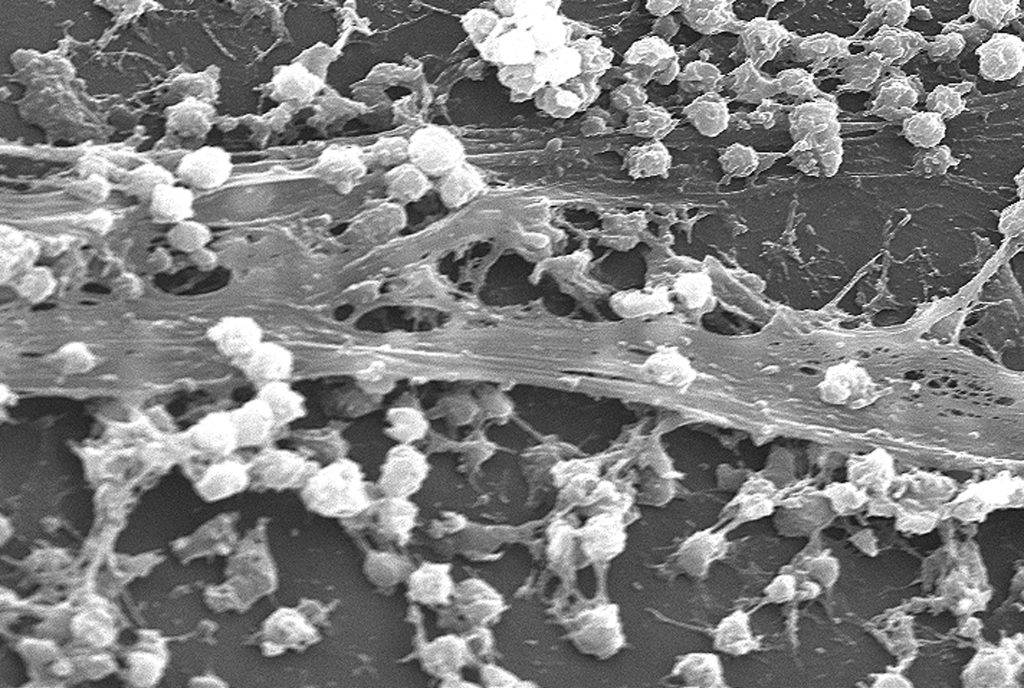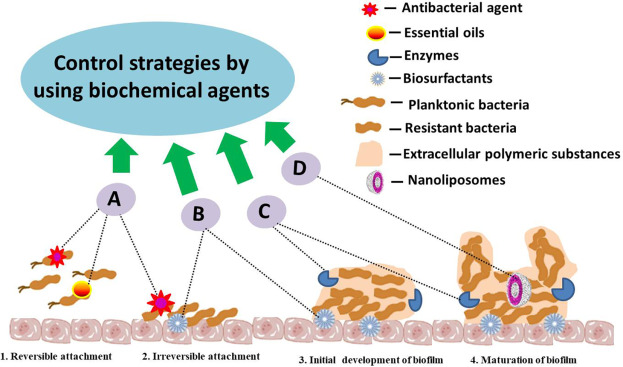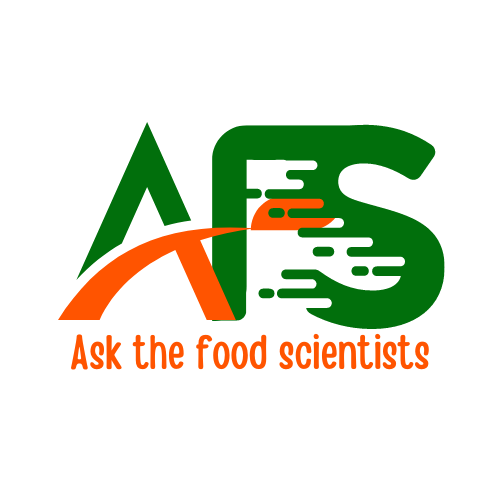Biofilms are thin layers of microorganisms that adhere to a surface and form a community. They are found in many different environments, including on food processing equipment, medical devices, and natural surfaces such as rocks and plants.
They are composed of microorganisms, such as bacteria and fungi, and the extracellular matrix that they secrete, which can include polysaccharides, proteins, and extracellular DNA. Biofilms can form on food processing equipment, such as conveyor belts, cutting knives, and storage tanks, and can harbor pathogenic bacteria that can cause food poisoning.
Food safety knowledge is for all!

Every consumer deserves to have high quality and safe food. …Read more!

They can also form on medical devices, such as catheters and prosthetic joints, and can lead to infections. Biofilms are also responsible for the corrosion of water pipelines, water tanks and also degrade the water quality.

In food industry, biofilm can be controlled by cleaning and sanitation procedures, regular monitoring of the equipment, and the use of chemical or physical methods to disrupt or remove them. In addition, some research has focused on developing methods to inhibit the formation, such as the use of antimicrobial agents, enzymes, and other biocides.
Find out more about the Microorganisms that mostly form biofilms.
Biofilm composition
Biofilms are composed of several different components, including:
- Microorganisms: The primary component of biofilms is microorganisms, such as bacteria, fungi, yeasts, cyanobacteria, archaebacteria and viruses, which can adhere to a surface and form a community.
- Extracellular matrix: The extracellular matrix is a complex mixture of molecules that the microorganisms secrete and is composed mainly of polysaccharides, proteins, and extracellular DNA. The extracellular matrix surrounds the microorganisms and provides structural support to the biofilm, helping to protect the microorganisms from the environment.
- Water: Biofilms require a moist environment to grow, so water is an important component of biofilms. The water in them can come from the surrounding environment or from the metabolism of the microorganisms.
- Nutrients: In order to grow and form a biofilm, microorganisms require a source of nutrients such as carbon, nitrogen, phosphorus and other minerals.
- Oxygen: Some microorganisms require oxygen to survive and form a biofilm, while others can form biofilms in anaerobic conditions.

- Other Inorganic and organic compounds: Some biofilms can also contain other inorganic and organic compounds such as pigments, enzymes and antibiotics, that are produced by the microorganisms.
- Immobilized cells: Dead cells, cellular debris and other metabolic byproducts can also be found in biofilms, these immobilized cells can contribute to the structure and can act as a source of nutrients for other microorganisms.
It’s worth noting that the composition can vary depending on the microorganisms present and the environmental conditions. The composition can also change over time as microorganisms die and new ones are introduced or as the environment changes.
Microorganisms that mostly form biofilms
ed by a wide variety of microorganisms, including bacteria, fungi, and even some viruses and protozoa. Some examples of microorganisms that are known to form biofilms include:
- Bacteria: Many different types of bacteria can form biofilms, including Escherichia coli, Pseudomonas aeruginosa, Staphylococcus aureus, and Streptococcus pneumoniae.
- Fungi: Fungi such as Candida albicans and Aspergillus niger can form biofilms on various surfaces.
- Yeasts: Yeast such as Saccharomyces cerevisiae, can form biofilms in industrial fermentation processes.
- Cyanobacteria: Cyanobacteria such as Microcystis aeruginosa, can form biofilms in water systems.
- Archaebacteria: Archaebacteria such as methanogens, can form biofilms in anaerobic environments.
- Actinobacteria: Actinobacteria such as Streptomyces sp, can form biofilms in soil and fermented food.
It is important to keep in mind that this list is not exhaustive and that many other microorganisms have the ability to form biofilms in different environments. Additionally, some microorganisms that are not typically associated with biofilm formation, such as Listeria monocytogenes, have also been shown to form biofilms under certain conditions.
Factors responsible for the formation of biofilms in food contact surfaces
There are several factors that can contribute to the formation of biofilms:
- Surface chemistry: The chemical properties of a surface can affect how easily microorganisms can adhere to it and form a biofilm. Surfaces that are hydrophobic, or that have a high surface energy, are less likely to support biofilm formation.
- Flow rate and turbulence: The flow rate and turbulence of liquids or gases can affect the ability of microorganisms to adhere to surfaces and form biofilms. Lower flow rates and higher turbulence can help to prevent biofilm formation.
- Nutrients: Adequate nutrients availability and suitable environmental conditions such as temperature and pH, are necessary for the formation and growth of biofilms
- Microorganism type: Different microorganisms have different abilities to form biofilms. Some microorganisms, such as Pseudomonas and Staphylococcus are more likely to form biofilms than others.
- Shear force: Shear forces, such as those generated by flowing fluids, can disrupt the formation and maintenance of biofilms.
- Temperature: Temperature also plays an important role in biofilm formation, as some microorganisms require specific temperatures in order to form and grow.
- Time: The longer a surface is exposed to microorganisms, the more likely it is that a biofilm will form.
- Presence of other microorganisms: The presence of other microorganisms can also affect biofilm formation, as some microorganisms can inhibit the growth of others.
It’s worth noting that biofilm formation is a complex process and often multiple factors are involved. The specific causes of biofilm formation can vary depending on the type of microorganism, the environment, and the surface on which the biofilm is forming.
Methods of controlling biofilms
There are several methods that can be used to prevent the formation of biofilms:
- Cleaning and sanitation: Regular cleaning and sanitation of equipment and surfaces can help to remove existing biofilms and prevent new ones from forming.
- Chemical treatments: Chemicals such as chlorine, hydrogen peroxide, and quaternary ammonium compounds can be used to clean equipment and surfaces and disrupt or remove biofilms.
- Physical treatments: Physical methods, such as high-pressure water jets, ultrasonication, and abrasive cleaning, can also be used to remove biofilms from equipment and surfaces.
- Antimicrobial agents: Antimicrobial agents, such as antibiotics, biocides and bacteriocins, can be used to inhibit the growth of microorganisms and prevent the formation of biofilms.

- Enzymes: Enzymes can be used to break down the extracellular matrix of biofilm, making it easier to remove them with cleaning and sanitation procedures.
- Surface modification: Surface modification can be done by coating the surface with material that are not favorable to the adhesion of microorganisms, such as silver and copper.
- Monitoring: Regular monitoring of equipment and surfaces can help to detect the presence of biofilm and allow for prompt removal.
- Good manufacturing practices: Compliance with good manufacturing practices (GMPs) that include proper sanitation and hygiene protocols can help to reduce the risk of biofilm formation.
It is important to note that the best method for preventing biofilm formation will depend on the specific application and the environment in which the biofilm is forming.
Our Blog ↗
Read the latest from our blog
Ask a Question ↗
Ask a question and get answers from our community
Give Feedback ↗
We value your feedback.


